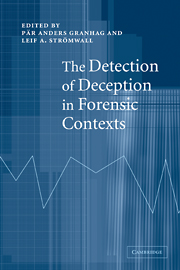Book contents
- Frontmatter
- Contents
- List of figures
- List of tables
- List of contributors
- Part 1 Introduction
- Part 2 Lie-detection techniques
- 2 Discerning lies from truths: behavioural cues to deception and the indirect pathway of intuition
- 3 Statement Validity Analysis and the ‘detection of the truth’
- 4 Reality monitoring and detection of deception
- 5 The psychophysiological detection of deception
- Part 3 Special issues facing a lie-catcher
- Part 4 Enhancing lie-detection accuracy
- Part 5 Conclusions
- Index
- References
3 - Statement Validity Analysis and the ‘detection of the truth’
Published online by Cambridge University Press: 22 September 2009
- Frontmatter
- Contents
- List of figures
- List of tables
- List of contributors
- Part 1 Introduction
- Part 2 Lie-detection techniques
- 2 Discerning lies from truths: behavioural cues to deception and the indirect pathway of intuition
- 3 Statement Validity Analysis and the ‘detection of the truth’
- 4 Reality monitoring and detection of deception
- 5 The psychophysiological detection of deception
- Part 3 Special issues facing a lie-catcher
- Part 4 Enhancing lie-detection accuracy
- Part 5 Conclusions
- Index
- References
Summary
The success of a criminal investigation often depends on witness statements, particularly if no other evidence is available. This is typically – although not exclusively – the case in sexual-abuse cases.
The fundamental question to be answered in evaluating a witness statement is whether or not (and to what extent) the statement is a correct and complete description of the event in question. Answering this question first requires the identification of potential sources of incorrect accounts. Based on this information appropriate diagnostic procedures and techniques can be applied in order to assess the probability of the correctness of the statement. An account may differ from the facts for two possible reasons (see Figure 3.1):
A witness, who is motivated to give a correct account of the events in question may be subject to unintentional errors, or
The witness deliberately and intentionally tells a lie.
The crucial difference between these alternatives is in the witnesses' motivation. Furthermore, in both cases one can think of stable personal or of transient situational factors as the major cause for incorrect accounts. For example, sensory or intellectual deficiencies may prevent a witness from perceiving or reporting certain events. On the other hand, darkness or lack of attention may result in incomplete perceptions in a certain situation. Similarly, intentional distortions or complete lies can be conceived as being caused by stable personality factors like antisociality (which affect what has been called ‘general credibility of the witness’) or by a situation-specific motivation to tell a lie (which impacts on the ‘specific credibility of the statement’).
- Type
- Chapter
- Information
- The Detection of Deception in Forensic Contexts , pp. 41 - 63Publisher: Cambridge University PressPrint publication year: 2004
References
- 96
- Cited by

